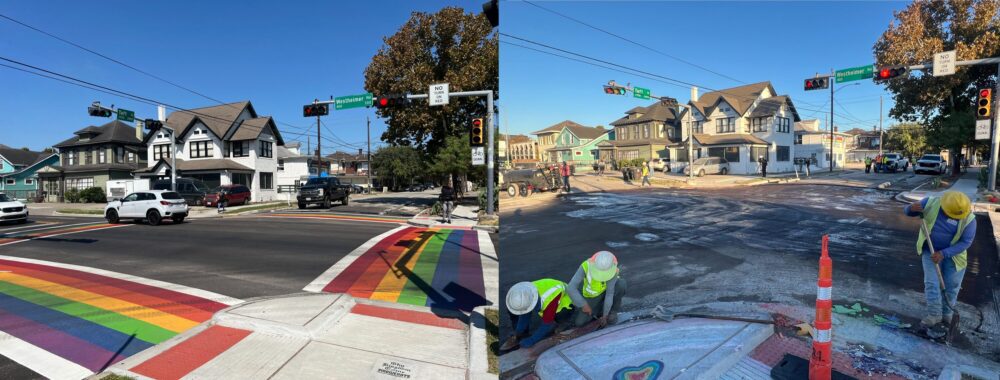
When the traffic signal turns green at the corner of Westheimer Road and Taft Street, it appears unremarkable, just another intersection in the sprawl of Houston. But for eight years, that stretch of pavement carried more than traffic. It carried memory, identity, and resistance. Painted in the vivid hues of the rainbow, the Montrose crosswalk was Texas’ first Pride crosswalk, a living landmark that reflected the soul of one of the state’s most storied LGBTQ+ neighborhoods.
It was installed in 2017 in honor of Alex Hill, a 21-year old community member killed in a hit-and-run near the same intersection. Funded by the Montrose Center and Pride Houston 365, the rainbow stripes weren’t just decoration; they were dedication, to Hill’s life, to queer visibility, to the neighborhood’s long lineage of love and defiance.

That legacy was abruptly interrupted on the night of October 20, 2025, when city crews, under order from the state, arrived just after midnight to strip the rainbow paint back to plain asphalt. Hours earlier, Texas Governor Greg Abbott had threatened to withhold transportation funds from any municipality that refused to remove what he called “political ideologies” from public roadways.
His directive, issued on October 8, cited a supposed safety concern, claiming that the colors of the crosswalk were “non-standard surface markings” that could confuse drivers. He invoked federal guidelines, declaring that only makings “directly supporting traffic control or safety” were permissible. Anything else, any symbol, flag, or artwork that conveyed “social, political, or ideological messages,” was to be scrubbed from the streets.
Abbott’s office framed it as a neutral matter of compliance and order. “Texans expect their taxpayer dollars to be used wisely, not to advance political agendas,” (even though that is exactly what miss girl is doing with this order) his statement read. “To keep Texans moving safely and free from distraction, we must maintain a consistent transportation network across Texas.”
Yet what followed looked less like consistency and more like censorship. METRO, Houston’s transit authority, quickly announced it would comply with the order to “preserve essential support.” Within days, workers were repainting the intersection, covering over a landmark that had, for nearly a decade, anchored the Montrose community’s sense of pride and remembrance.
The backlash came fast. Residents and business owners in Montrose were devastated, calling the decision a petty political stunt. Some gathered at the intersection, forming a peaceful blockade until police moved in to make arrests. Four protestors were detained and later released. By morning, residents had covered nearby sidewalks in chalked rainbows and hearts, transforming grief into quiet defiance.
For them, this was more than about paint, it was about history. The Montrose Center released a statement recalling that the crosswalk was created “in memory of Alex Hill and as a testament to the LGBTQ+ community’s visibility and resilience.” Pride Houston 365 called the removal “an act of state-sanctioned erasure,” warning that “when you erase our colors, you attempt to erase our people.”
Houston City Council member Abbie Kamin, who represents the Montrose area, was blunt—”Greg Abbott has no legal basis to interfere with the people of Houston or Harris County,” she said. “He’s wasting time obsessing over paint while over a million Texans risk losing health care, grocery prices soar, and extreme weather batters our communities. We have real problems that demand real leadership, not wannabe Trump trampling on the rights of our people.”
Her words echoed through a state that has, in recent years, become ground zero for what many describe as an orchestrated rollback of LGBTQ+ visibility.
Governor Abbot’s order is not an isolated act, it’s the latest in a deliberate pattern by conservative leaders in states like Texas and Florida who have turned governance into a tool of cultural warfare. From book bans and drag show restrictions to the targeting of trans healthcare and education, the assault on queer visibility is expanding beyond laws and classrooms, now seeping into the literal infrastructure of public life.
When a crosswalk becomes a battleground, it tells us something about the fragility of state power. The rainbow on the street is not dangerous. What’s dangerous is a government that believes color is chaos, that believes belonging itself is a political provocation.
Abbott’s rhetoric about “safety” masks an older playbook, weaponizing bureaucracy to enforce invisibility. By defining the rainbow as a political ideology, he renders queerness a threat, something to be managed, sanitized, or erased under the guise of neutrality. But neutrality in the face of identity is never neutral. It is the quiet violence of dominance, the insistence that only certain lives, certain loves, belong in public view.
In the days since the removal, Montrose has responded with what queer communities have always known best, which is creation. Sidewalks glow with chalk art, window banners rise in defiance, and local artists have vowed to repaint the stripes once again when the tome comes. The rainbow has never belonged to the state; it has always belonged to the people.
This is the paradox of power—you can strip the street, but not the spirit. You can dull the colors, but cannot unmake the memory.
And so, while Texas officials claim to be preserving uniformity, what they truly are preserving is a fear of difference. Yet across Montrose, and across the South, that fear is met with a greater force—the unrelenting, radiant insistence of queer life to be seen.
The road may look gray again today. But under that gray lies every color that once was, and every color that will return.